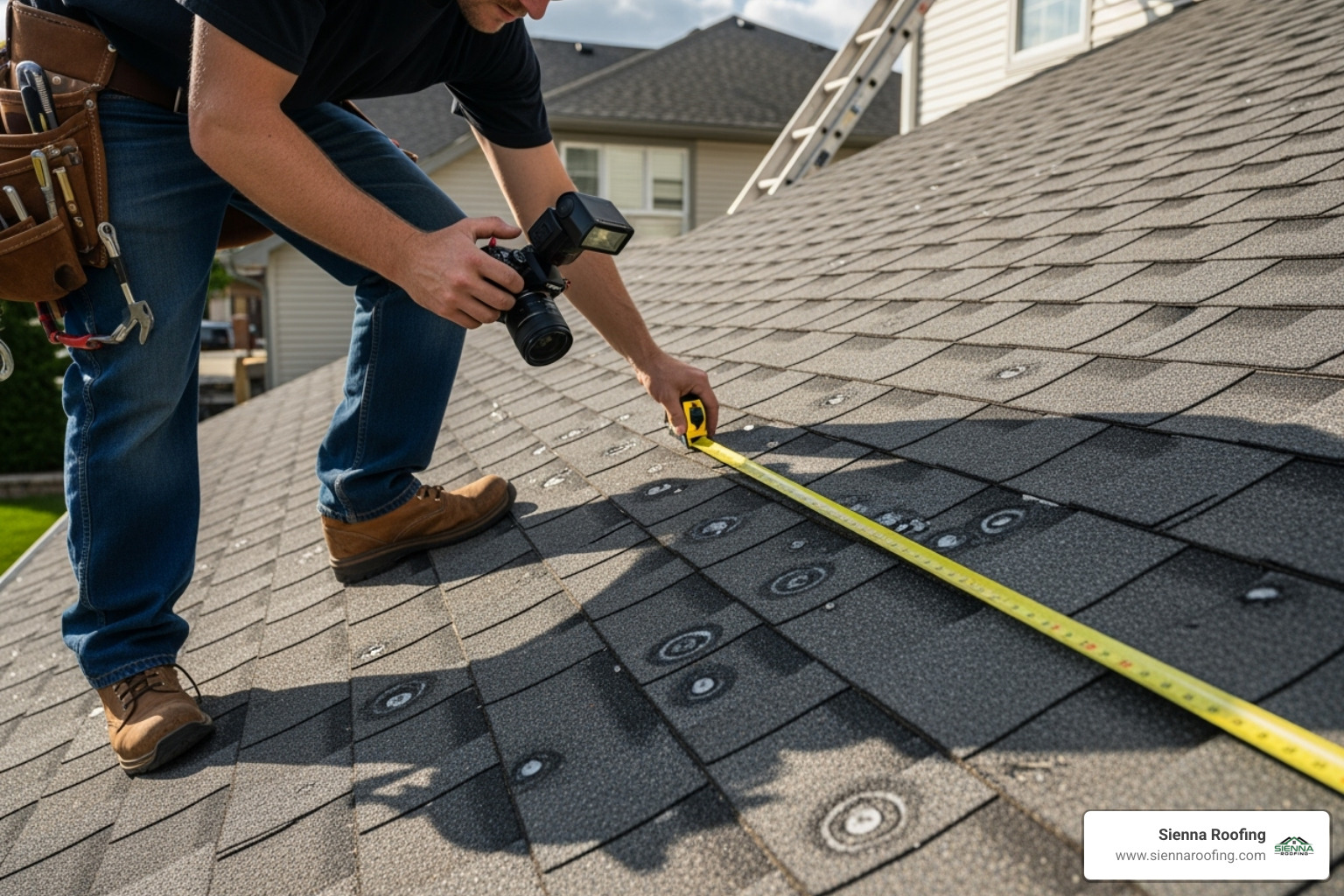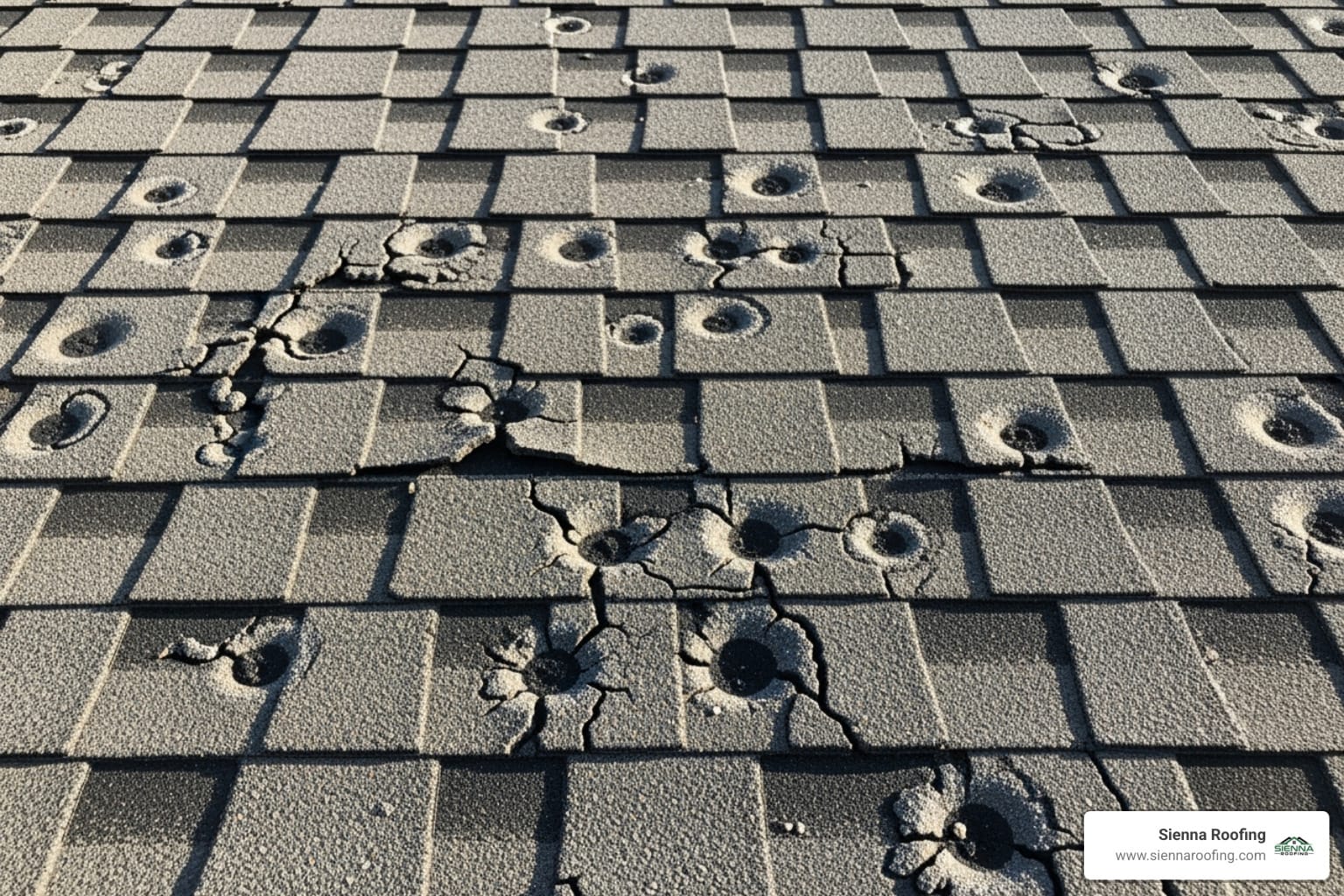Why Identifying Hail Damage Early Matters
After a hailstorm, your roof may appear fine from the ground, but hidden damage can lead to costly problems. Knowing how to tell if roof needs repair from hail damage is the first step to protecting your home and connecting with a trusted local roofing company. Hidden damage can quickly escalate, leading to leaks, mold, and structural issues.
Quick Signs Your Roof May Need Hail Damage Repair:
- Dented gutters and downspouts – Look for dings above 5 feet (can’t be blamed on lawnmowers)
- Granules in gutters – Shingle granules washed down indicate surface damage
- Dark spots on shingles – Circular marks where hail knocked off protective granules
- Damaged collateral items – Dented AC units, torn screens, chipped paint on siding
- Soft spots on shingles – Areas that feel bruised when pressed gently
- Missing or cracked shingles – Obvious signs of impact damage
Hail causes about $1 billion in property damage annually in the United States. What starts as minor granule loss can escalate into leaks and structural issues that cost thousands more to repair. For Houston-area homeowners, knowing how to identify storm damage is especially crucial.
I’m Andre Castro, CEO of Sienna Roofing & Solar. With over five years of roofing experience, I’ve seen that early detection is the key to protecting both your home and your wallet when learning how to tell if roof needs repair from hail damage.
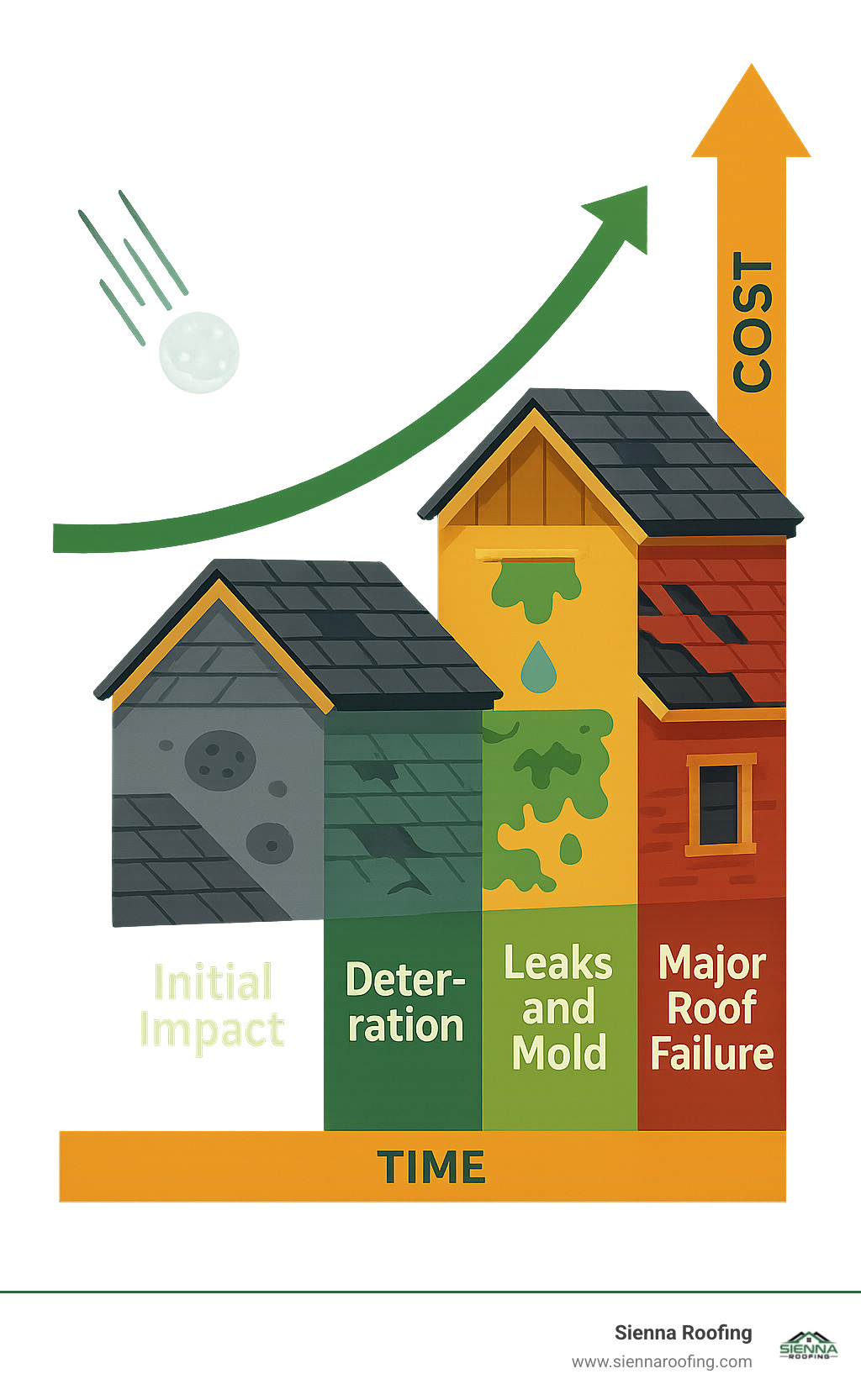
Know your how to tell if roof needs repair from hail damage terms:
Start with a Safe, Ground-Level Inspection
Your how to tell if roof needs repair from hail damage journey should always begin with your feet firmly on the ground. A thorough ground-level inspection often reveals the most telling signs of hail damage—and it’s infinitely safer than climbing onto a potentially compromised roof.
Check for Collateral Damage Around Your Property
Hail leaves evidence everywhere it goes. When determining if your roof took a beating, start by looking at everything else the storm hit. Dented gutters and downspouts are often your first clue; look for dings above five feet high, where a lawnmower couldn’t reach. Your damaged downspouts tell a similar story.
Also, examine your property for cracked vinyl siding, chipped paint on exterior surfaces, torn window screens, and dented AC unit fins. These provide valuable clues about what your roof endured. If your mailbox or car is dented, your roof likely experienced something similar. This collateral damage gives a clear picture of the storm’s intensity without any guesswork.
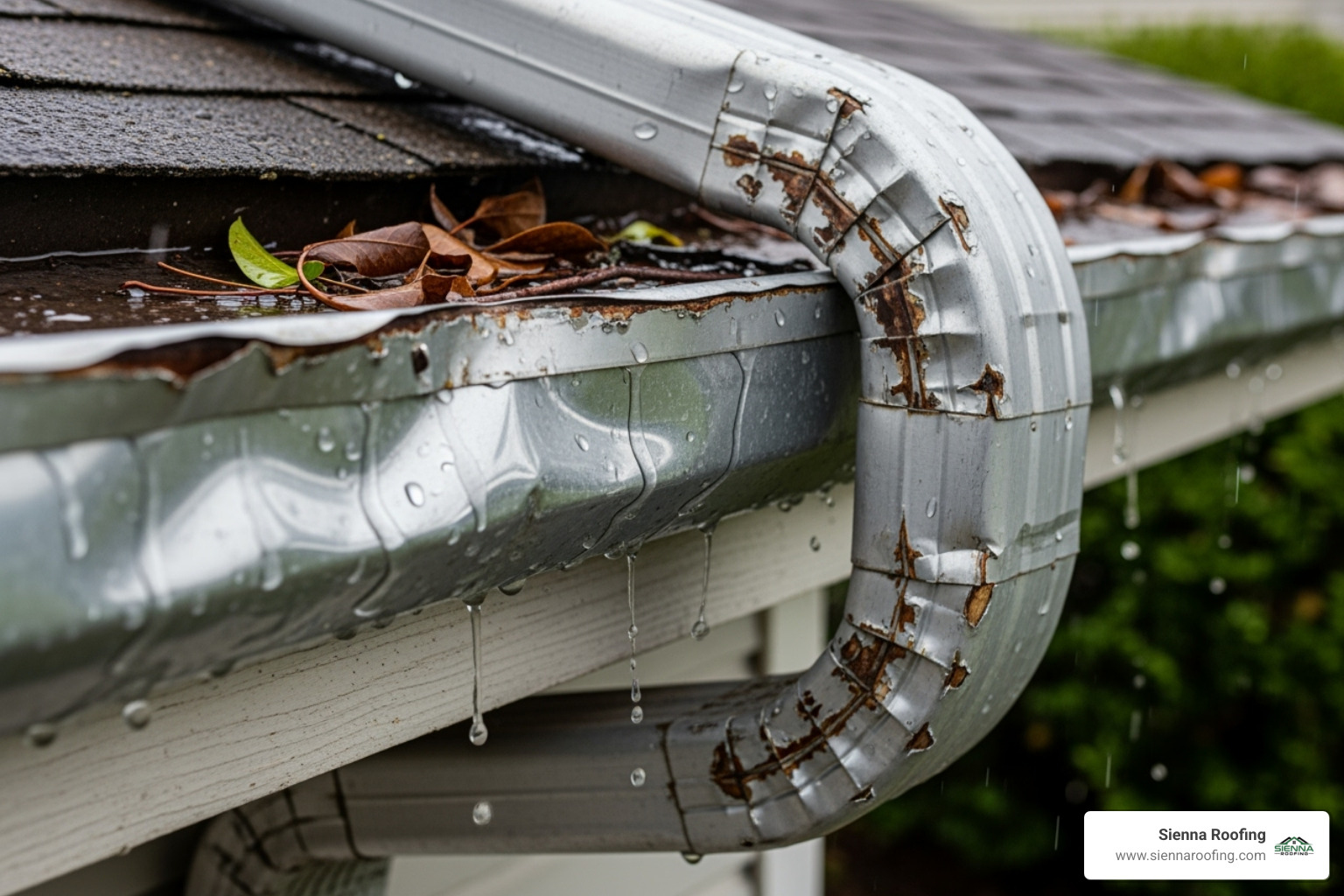
Look for Granules in Your Gutters
This is a critical part of your ground-level inspection. Those tiny asphalt shingle granules are your roof’s armor, protecting it from UV ray exposure and weather. After a hailstorm, look in your gutters and at the base of downspouts. If you see what looks like a sandpaper-like texture of accumulated granules, that’s a red flag.
Granule loss from a storm indicates impact damage that can lead to the accelerated aging of your shingles. Without that protective coating, your roof becomes vulnerable. Be sure to document this evidence—it’s a key sign of hail damaged shingles that your insurance adjuster will want to see.
Identifying Hail Damage on Different Roofing Materials
Hail damage isn’t a one-size-fits-all situation. Understanding how to tell if roof needs repair from hail damage means recognizing that damage on asphalt shingles looks different from damage on a metal roof. Each material shows hail impact in its own way.
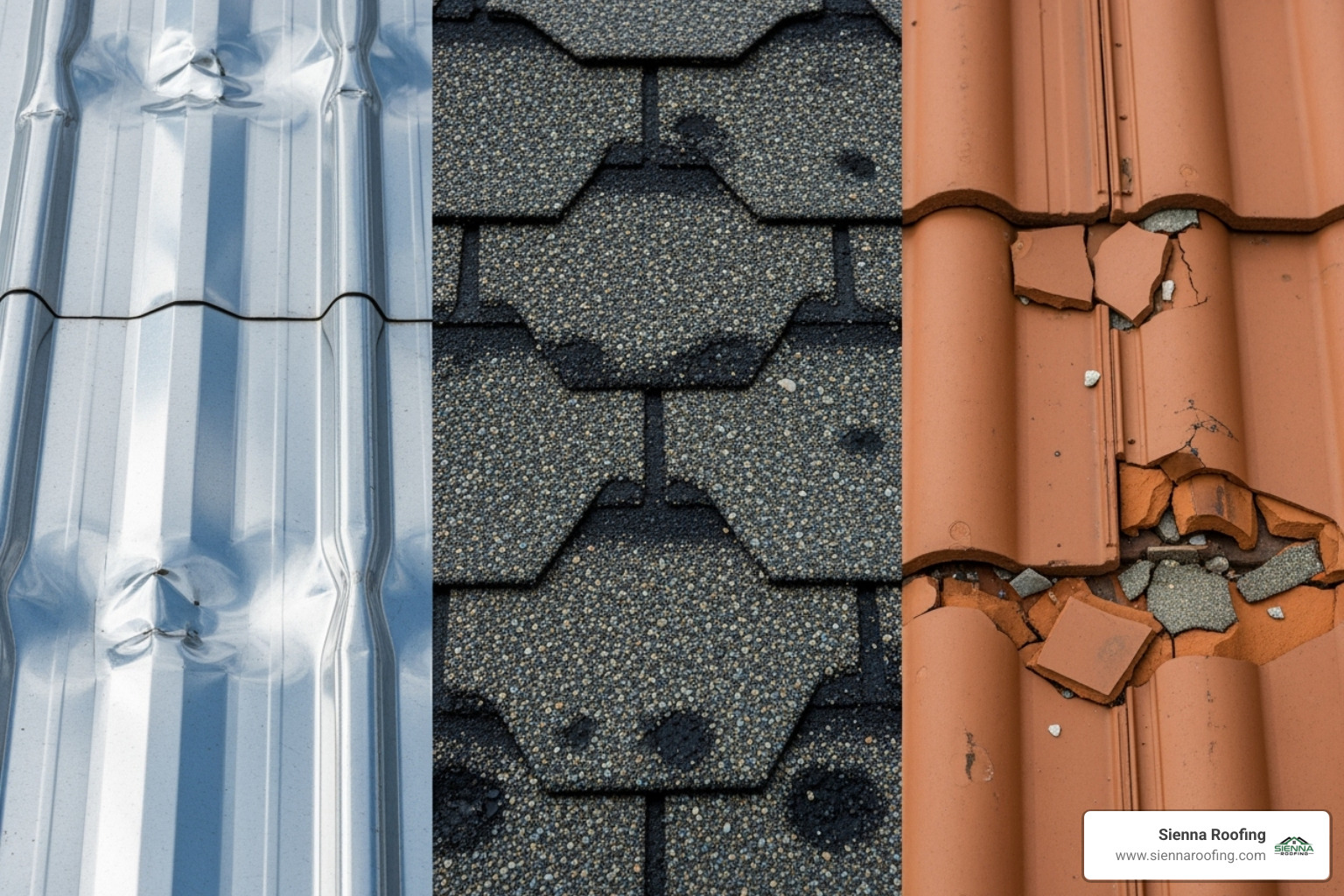
Signs of Hail Damage on Asphalt Shingles
Asphalt shingles show hail damage through random damage patterns. Look for black or dark spots where granules have been knocked away, revealing the underlying asphalt mat. These spots may have a shiny appearance from the impact. A key sign is a soft, bruised feeling when you press gently on impact areas, indicating the mat is fractured. This exposed roof felt leads to premature aging and leaks. For a comprehensive look, see our guide on hail damage to asphalt shingles.
How to Tell if a Metal Roof Needs Repair from Hail Damage
Dents and dings are the primary calling cards of hail on metal roofs. It’s important to distinguish between cosmetic and functional damage. While small dents affect curb appeal, damage that compromises the protective coating is more serious. Scratches that expose bare metal can lead to rust and eventual leaks. Very large hail can even cause punctures on older or thinner metal.
Damage on Wood, Slate, or Tile Roofs
These materials show hail damage distinctly. Look for cracked or broken tiles. Wood shakes and shingles typically split along their grain, leaving sharp, fresh edges that look different from natural weathering. Slate and tile roofs often show broken corners or chips. Any sudden appearance of cracks after a storm is worth investigating.
Distinguishing Hail Damage from Other Issues
Not every roof problem is hail-related. Normal wear and tear is gradual and uniform, unlike the random patterns of hail. Other issues like blistering, thermal cracking, and algae growth have different causes and appearances. True hail damage is characterized by random impacts with fresh, sharp edges or a “bruised” feel on asphalt shingles. When in doubt, a professional inspection can confirm the cause and prevent false alarms.
Factors That Influence Hail Damage Severity
Not all hailstorms are created equal. The severity of hail damage depends on a fascinating interplay of factors that go beyond just the size of the ice falling from the sky. Wind, your roof’s age, and storm intensity determine whether you’re looking at minor repairs or a major roofing project.
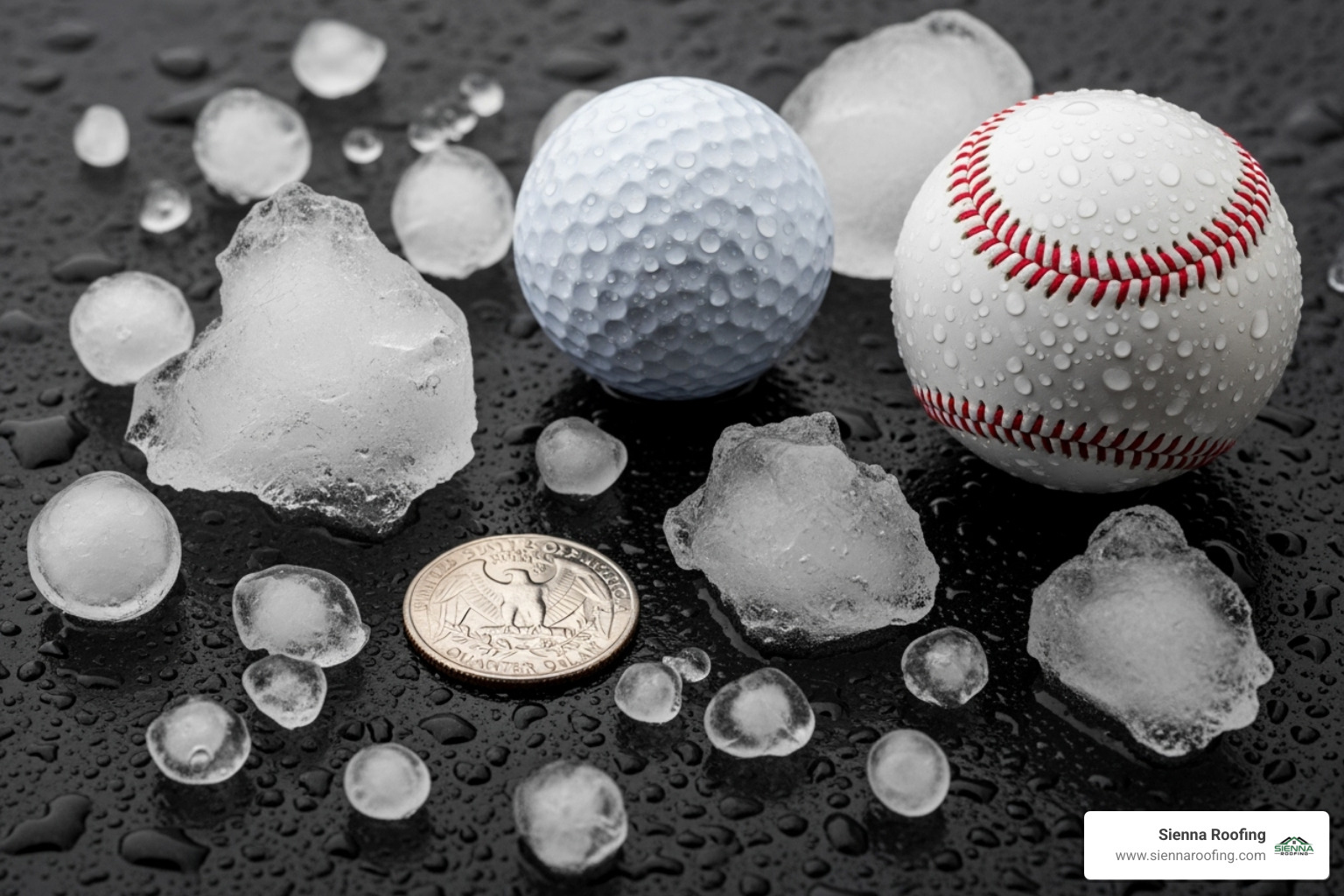
How Big Does Hail Need to Be to Cause Damage?
While bigger seems worse, the reality is more nuanced. Hail typically needs to reach about 1 inch in diameter—roughly the size of a quarter—to cause clear damage to standard asphalt shingles.
However, wind speed and direction play a massive role. Wind-driven hail has a much greater impact force. The hail’s density and shape also matter; jagged stones can be more destructive. According to NOAA’s hail formation science, these irregular shapes are common. Even small, wind-driven hail can cause significant granule loss that accumulates over time, dramatically accelerating your roof’s aging process.
The Role of Your Roof’s Age and Condition
Your roof’s current condition is like its immune system. Older roofs are significantly more vulnerable because the shingles become brittle over time. A 20-year-old roof might suffer extensive damage from the same hailstorm that barely affects a 5-year-old roof.
Previous damage creates weak points that make your roof more susceptible. The roof slope also influences damage patterns. A well-maintained roof with healthy, flexible shingles and no existing damage can often weather moderate hailstorms with minimal issues, which is why regular maintenance is so important.
What to Do After You Spot Hail Damage
Finding potential hail damage can feel overwhelming, but taking the right steps immediately can make all the difference. How to tell if roof needs repair from hail damage is just the beginning—what you do next is critical.
Document Everything and Contact a Professional
Your smartphone is your best friend. Take clear photos and videos of everything you found during your ground-level inspection. Note the date and time of the storm. This creates a clear timeline for insurance purposes.
Here’s what’s absolutely crucial: do not climb on your roof yourself. A potentially damaged roof presents serious safety risks. Instead, call a professional roofing contractor for a comprehensive assessment. A professional roof inspection gives you the complete picture of your roof’s condition and provides the documentation you’ll need for insurance claims.
Understanding the Insurance Claim Process
Most homeowners insurance policies cover hail damage. However, understanding your specific coverage can save you from surprises. Know your policy type: an Actual Cash Value (ACV) policy pays the depreciated value of your roof, while a Replacement Cost Value (RCV) policy is more comprehensive. You’ll also have a deductible to pay out of pocket.
Time is of the essence. Most insurance companies give you up to one year to file a claim, but acting quickly is always better. When your insurance adjuster arrives, having your chosen roofing contractor present can make a significant difference. Learn more about navigating roofing insurance claims to understand the full process.
How to Tell if Your Roof Needs Repair from Hail Damage or a Full Replacement
This is where professional expertise becomes invaluable. The decision between repair and replacement depends on several factors. Minor, isolated damage might only require replacing a few shingles. However, when hail damage is widespread, a full replacement is often more practical.
Insurance companies often use a “test square” methodology; if there are 8 to 10 or more hail strikes within a 100-square-foot area on multiple roof sections, it typically warrants a full replacement. The severity of each impact also matters. Functional damage that compromises your roof’s ability to protect your home often necessitates replacement. A reputable contractor will provide an honest assessment based on their professional judgment.
Frequently Asked Questions about Roof Hail Damage
When it comes to how to tell if roof needs repair from hail damage, we hear the same questions from homeowners throughout the Houston area. Let me address the most common concerns.
Can I prevent hail damage to my roof?
While you can’t stop a hailstorm, you can mitigate potential damage. The best defense is choosing Class 4 impact-resistant shingles. These are specially designed to withstand large hail impacts. The Insurance Institute for Business & Home Safety provides IBHS Shingle Performance Ratings that help you compare different materials.
Beyond materials, regular maintenance plays a huge role. A roof that’s already compromised will fare much worse in a hailstorm than one that’s been well-maintained.
Will my insurance rates go up if I file a hail damage claim?
This is a common worry, but hail damage claims typically don’t increase your individual premium. Insurance companies classify hail as an “Act of God,” which is different from claims caused by negligence. You might lose a “claims-free discount,” but your base premium shouldn’t spike. However, when widespread storm damage affects an entire region, insurance companies may adjust rates for that whole area. It’s always best to discuss specifics with your insurance agent.
How long do I have to file an insurance claim for hail damage?
Time is more critical than many homeowners realize. Most insurance policies give you one year from the date of the storm to file a claim, but this can vary. Acting quickly makes it easier to prove which storm caused your damage. The smart approach is to get a professional inspection as soon as possible after any significant hail event. This ensures that any damage doesn’t have time to worsen.
Protect Your Home from Future Storms
Knowing how to tell if roof needs repair from hail damage is your first line of defense, but taking action is what truly protects your home. Ignoring hail damage is a risk not worth taking. Minor bruises and granule loss can allow water to seep through your roof’s protective barrier, leading to leaks, mold, and structural damage.
You now have the tools to take control. By performing the safe ground-level inspection we discussed, you can quickly assess whether your roof likely sustained damage. If your inspection reveals signs of hail damage, don’t wait. The sooner you address potential issues, the better protected your home will be.
At Sienna Roofing, we’ve seen too many homeowners wait months after a storm, only to find that minor hail damage had caused far more extensive problems. Our team provides comprehensive roof inspections that go beyond what you can see from the ground. We’re proud to serve the Houston area, including Sugar Land, where severe weather is simply part of life.
Your home is likely your biggest investment. Don’t let hail damage compromise it. For a complete assessment and expert help with your roofing storm damage repair needs, contact us today.
